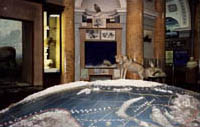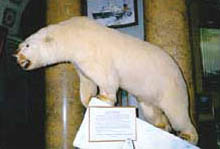
support team
The Russian State Arctic and Antarctic Museum
The Russian State Arctic and Antarctic Museum is the only Russian cultural and educational institution which covers the Polar theme in full and the largest of its kind in the world. It is a unique museum of the local history of polar countries. The scientific concept of the museum was created under the guidance of leading Soviet polar scientists. The building where the museum is located was built in 1838 and is now an architectural monument of the first half of the 19th century, as mentioned by the project architect A.I. Melnikov.


Antarctic Museum
On November 22nd, 1930 by Decree of the President of the Central Executive Committee of the USSR, the USSR Arctic Institute, and its department: The Arctic Museum was established. After the reconstruction and repair on January 8th, 1937 it was reopened for viewing. The basis of the Museum collection was exhibits of polar exhibitions, held since 1923 in Leningrad, Moscow and Archangelsk. During the Great Patriotic War of 1941-1945, the Museum was evacuated to Krasnoyarsk and on March 1950 it reopened its doors for attendees again.
In connection with the start of the USSR’s research in Antarctic, in 1956-1958 the Museum opened its new section “Antarctic” and got another name: The Arctic and Antarctic Museum.
In the 90s, when Russia’s leading positions in development and exploration of polar regions were starting to weaken, the expositions of the Russian State Arctic and Antarctic Museum and its archives became unique historical monuments of world significance. The Museum still continued to keep cultural and historical traditions of Saint Petersburg as a center of Russian polar explorations. Keeping accurate and accessible information for the masses is especially important now, especially when there’s a keen interest in reviving the Russian Arctic.
In 1998, in connection with a Decree of the Russian Government, the museum was separated from the institute and became a State institution.
Main museum excursions
Arctic Nature
In the section “Arctic Nature” there are exhibits that characterize physical and geographical peculiarities of the Arctic, its animal and plant kingdom. Dioramas Bird colony on the seashore, Walrus rookery, Tundra in winter, Tundra in summer, Shokalsky glacier on Novaya Zemlya, and Strait Matochkin Shar, are all unique art works made by the authors Platunov and Tsypalin in 1935-1936.
The central part of the exposition is the model “Arctic”, which is a segment of the globe with relief plaster, a metric map of the northern hemisphere to the 60° parallel on the scale of 1:1500000. The model was made on the initial works of the cartographic materials of Y.M. Shokalsky in 1936.


Antarctic Museum
The Antarctic
The exposition of this section describes the nature of the sixth continent, history of its opening, the most important foreign expeditions and the activity of the Soviet Antarctic expeditions.
The first ones who saw the Antarctic coast were the Russian seafarers F. Bellinsgauzen and M. Lazarev. On their ships “Vostok”, and “Mirny” they made their way through drifting ice and chains of gigantic icebergs and on January 28th, 1820 they discovered the continent and it was later named Antarctica. Having continued their circumnavigation, they sailed around Antarctica and discovered the Island of Peter the First and the Land of Alexander the First.
In the section of the exposition dedicated to the largest geographical discovery of the 19th century, there is the first edition of the map of captain Bellinsgauzen’s travel across the South Arctic Ocean and around the world in 1819, 1820 and 1821. It was then published in 1831 in Saint Petersburg and had a very small circulation.


The history of discovery and exploration of the North Sea Way
Rich with outstanding events, the history of Arctic navigation opened for attendees with this section.
Courageous Russian coast-dwellers were pioneers of sailing the North Arctic Ocean. On small sailing vessels, coches, they sailed to Spitsbergen and Novaya Zemlya then gradually moved forward to the east along the Eurasian northern coasts, moving closer to the moment of discovery of the North Sea Way from the Atlantic Ocean to the Pacific. For the first time, in 1648 Semyon Dezhnyov, the service class man, sailed through the strait between Eurasia and North America and proved that these were two separate continents.
In this section one can view the fragments of the ship′s exterior and part of the stem of the ancient coch. There are also reconstructed clothes of polar seafarers of the 16th-17th centuries and other relics of the pioneers of the North Seas.


North Seas pioneers
Today sailing the North Sea way has been made available by dozens of polar hydrometeorological stations, special ice and air reconnaissance and Earth’s artificial satellites.
The existing model “Aurora Polaris” acquaints attendees with this surprising phenomenon of nature and that concludes the exposition for this section.
The National Economy and Cultural Development of The Far Northern Regions
Exposition of the section “The National Economy and Cultural Development of the Far Northern Regions” describes the economic and culture development of the Russian northern regions. The very north of Russia possesses the richest reserves of minerals. It has only been in the last 10 years that these names have been discovered: apatite, nepheline, copper and nickel deposits of the Kola Peninsula, coal and oil deposits of coast and offshore areas of Karskoye and Pechorskoye sea, oil provinces of Ob river inner flow, large deposits of nickel, copper and coal in Enisey river inner flow, tin and diamond deposits of Chukotka. On the base of these deposits modern combines were built. The collection of minerals clearly demonstrates the growing development of the mining industry.
Nenets, Samis, Koryaks, Evenks, all those, who have been living in tundra and taiga for a very long time, have a deep love for the Polar regions from birth. The beauty of the northern distant regions, rich colours of tundra covering, and the Arctic natural effects are reflected in the works of the Northern people. Their fancy traditions are expressed in different shapes on clothing and articles of everyday use. Nenets rugs were made from seal skin, decorated with coloured beads, and encrusted arctic fox fur, are the essence of this unique collection, which were added to the Museum from the All-Russia Exhibition Center in 1950. Works of the Uelen bone carving workshop (carving on mammoth and walrus bones in the 30s of the 20th century) are very solid, original and expressive. North primitive was formed as a new branch of visual art in the 30-40s of the 20th century in the art workshop of The Institute of Northern people, which is represented in the museum by sculpture, painting and graphics. The works of students of The Institute of Northern people were awarded a Honourary Diploma in 1937 when they made a presentation at the Paris exhibition.
The most valuable, unique collections of the museum:
An archaeological collection of subjects of coast-dwellers’ life of the first half of the 17th century, found in Taimyr and West Siberia
A collection of decorative and applied arts of the Northern people, including works of Uelen’s bone carving workshop of the 1930s-40s, articles of clothing and everyday use made from the skins of deer and sea animals
A collection of articles of visual art students of the Institute of Northern people of the 1930s (paintings and sculptures)
A set of equipment units and the outfit of the First drifting station “North Pole” of 1937-1938
The Numismatic collection of the museum (4000 units) includes coins of the 16th-17th centuries, marks, badges on polar topic, order of the USSR, Norway, the USA and other countries, Soviet and foreign medals, awarded to explorers of polar regions. A unique collection of medals in honour of the Cheluskin epic, dedicated to its participants and pilots: the first heroes of the USSR.
One of the most interesting museum expositions is the collection is dedicated to Polar Philately. With the beginning of the Arctic and Antarctic exploration by man, postal communication with the “main land” gradually developed. Envelopes, post cards, and cards, sent from different expeditions, were proof of events of polar history. All the countries, that took part in Arctic and Antarctic exploration and development, dedicated lots of issues of their stamps to famous polar travelers and scientists, icebreakers and scientific vessels, pictures of severe nature conditions and the animal kingdom of the Polar Regions. All these envelopes and stamps decorate the polar collections of philatelists of the world and their best samples are presented in the Museum’s collection.
At present the museum’s collection consists of 75 000 exhibits. Among them are unique exhibits, dating back to the 16th century. During 70 years of its work the museum organized more than 300 exhibitions in Russia and abroad. More than 6 million attendees got acquainted with its collections. The Russian State Museum of Arctic and Antarctic became an integral part of the cultural life of Saint Petersburg and Russia.
|
Contact information: |